Discover the timeless beauty and architectural splendor of Bangladesh through its stunning historical mosques. This South Asian nation is home to over a thousand years of Islamic heritage, reflected in these sacred structures that stand as symbols of faith, history, and cultural richness. From the iconic Sixty Dome Mosque in Bagerhat to the elegant Star Mosque in Dhaka, each mosque tells a story of ancient craftsmanship and religious devotion. In this article, we explore 15+ beautiful historical mosques in Bangladesh that are must-visits for architecture enthusiasts, travelers, and history lovers. Whether you're planning a heritage tour or simply curious about Islamic architecture, these landmarks offer a captivating glimpse into Bangladesh’s glorious past.
15 Most Beautiful Historical Mosques in Bangladesh:
Bagha Shahi Mosque:
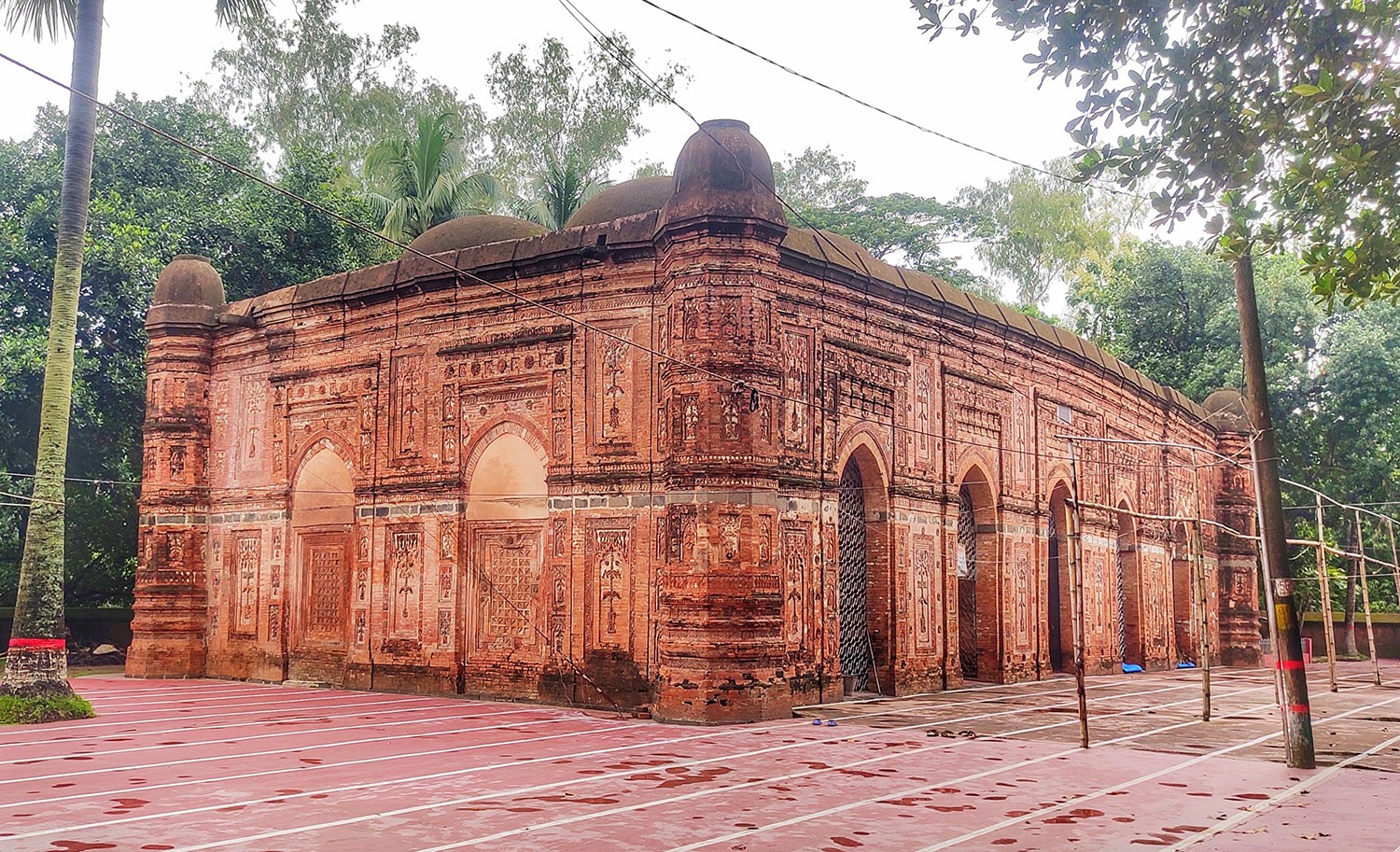
Built in 1523 by Sultan Nusrat Shah, Bagha Mosque stands as a stunning testament to the grandeur of the Hussain Shahi architectural tradition. Located in Rajshahi, this historic mosque is renowned for its elegant structure and intricate ornamentation.
The mosque features ten small, inverted cup-shaped domes, giving it a balanced and harmonious silhouette. Its true distinction, however, lies in the exquisite terracotta embellishments that adorn every surface. These finely detailed artworks display lush floral motifs, clusters of grapes, and delicate rosettes—especially prominent on the mihrabs.
The western inner wall of the mosque is particularly notable, with three richly decorated mihrabs positioned in the southern bays. The fourth bay features a paneled design, while the fifth contains a smaller mihrab on its upper level. The central mihrab stands out for its masterful craftsmanship—a floral framework surrounds the niche, and the spandrels are sculpted with a profusion of vegetation, all interwoven around a bold central rosette.
Sixty Dome Mosque:

Among the remarkable surviving monuments of the Khan Jahan style in Bagerhat, the Sixty Dome Mosque stands out as the largest and most magnificent brick mosque in Bangladesh. Despite its popular name, the mosque is actually crowned with 77 small domes, including seven distinctive chau-chala Bengali domes along the central row.
Construction of this architectural marvel began in 1442 and was completed in 1459. Today, it is recognized as a UNESCO World Heritage Site and has been hailed as “the most impressive Muslim monument in the entire Indian subcontinent.”
The mosque’s prayer hall measures an impressive 160 by 190 feet and can accommodate around 2,000 worshippers at a time. Eleven arched doorways grace the eastern facade, with seven more on both the northern and southern sides, providing ample light and ventilation.
Inside, the sanctuary is divided by a dense forest of slender stone columns into seven longitudinal aisles and eleven deep bays. From these arches rise endless rows of elegant curves that support the domes overhead. The walls, nearly six feet thick and slightly battered, along with nearly detached circular corner turrets topped with small rounded cupolas, evoke the impression of a fortress’s bastions.
Choto Sona Masjid:
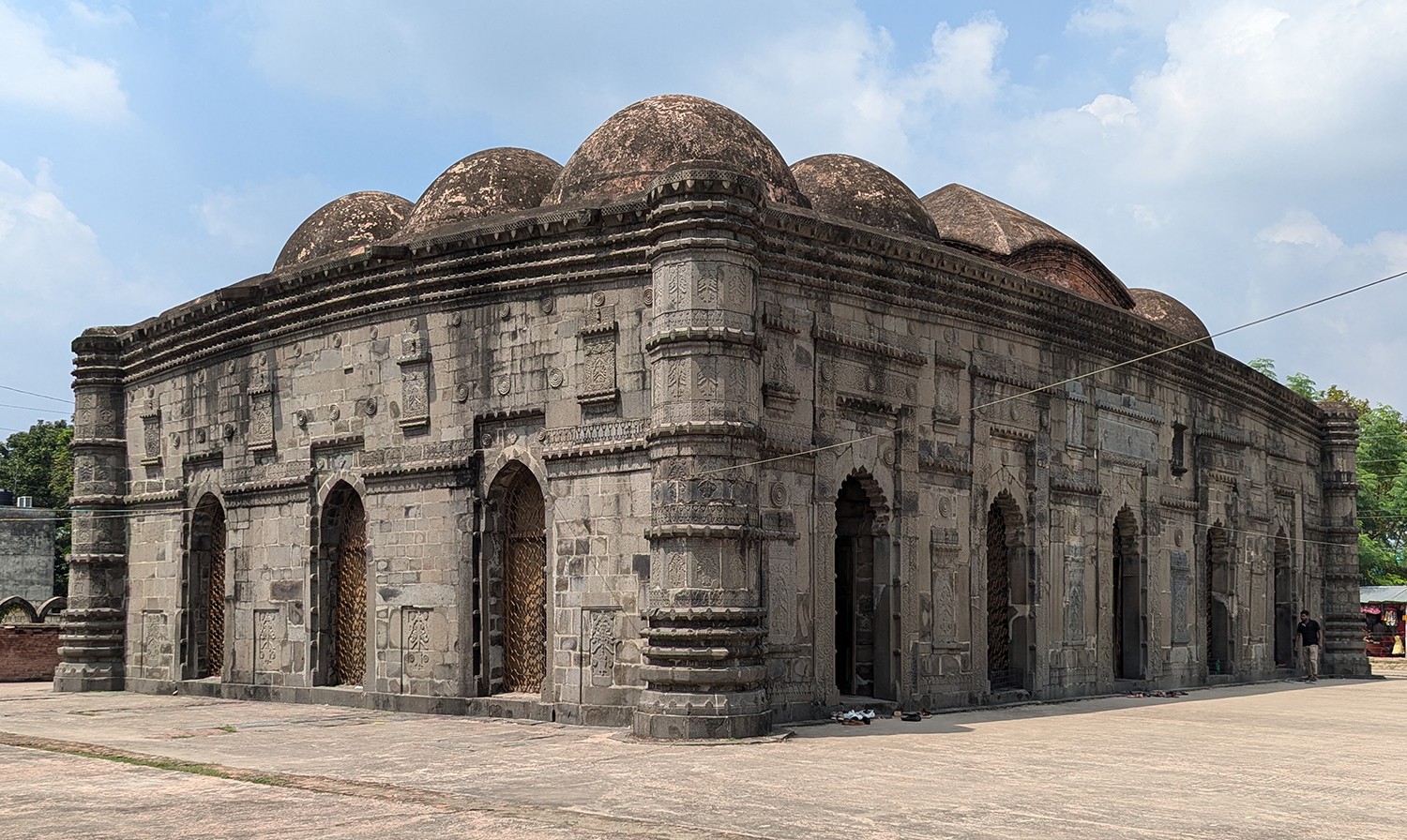
The Chhoto Sona Masjid, meaning Small Golden Mosque, is a magnificent architectural gem from the late 15th to early 16th century. Built by Wali Muhammad between 1493 and 1519 during the reign of Sultan Alauddin Hussain Shah, this mosque stands in the ancient and affluent capital of Bengal, Gaur.
The mosque earned its name from its original gilded domes—fifteen in total—including three distinctive chau-chala domes in the central row. These golden domes once shimmered in the sun, giving the structure its iconic title.
What truly sets Chhoto Sona Masjid apart is its exquisite decorative artistry. Intricate carvings in shallow relief adorn both the inner and outer walls, reflecting the finesse of Bengal’s traditional terracotta craftsmanship. The stonework bears striking resemblance to the region’s celebrated wood-carving and filigree styles. The sanctuary floor was once covered in beautifully glazed tiles featuring delicate floral motifs, adding to the mosque’s elegance.
Dhunichak Mosque:
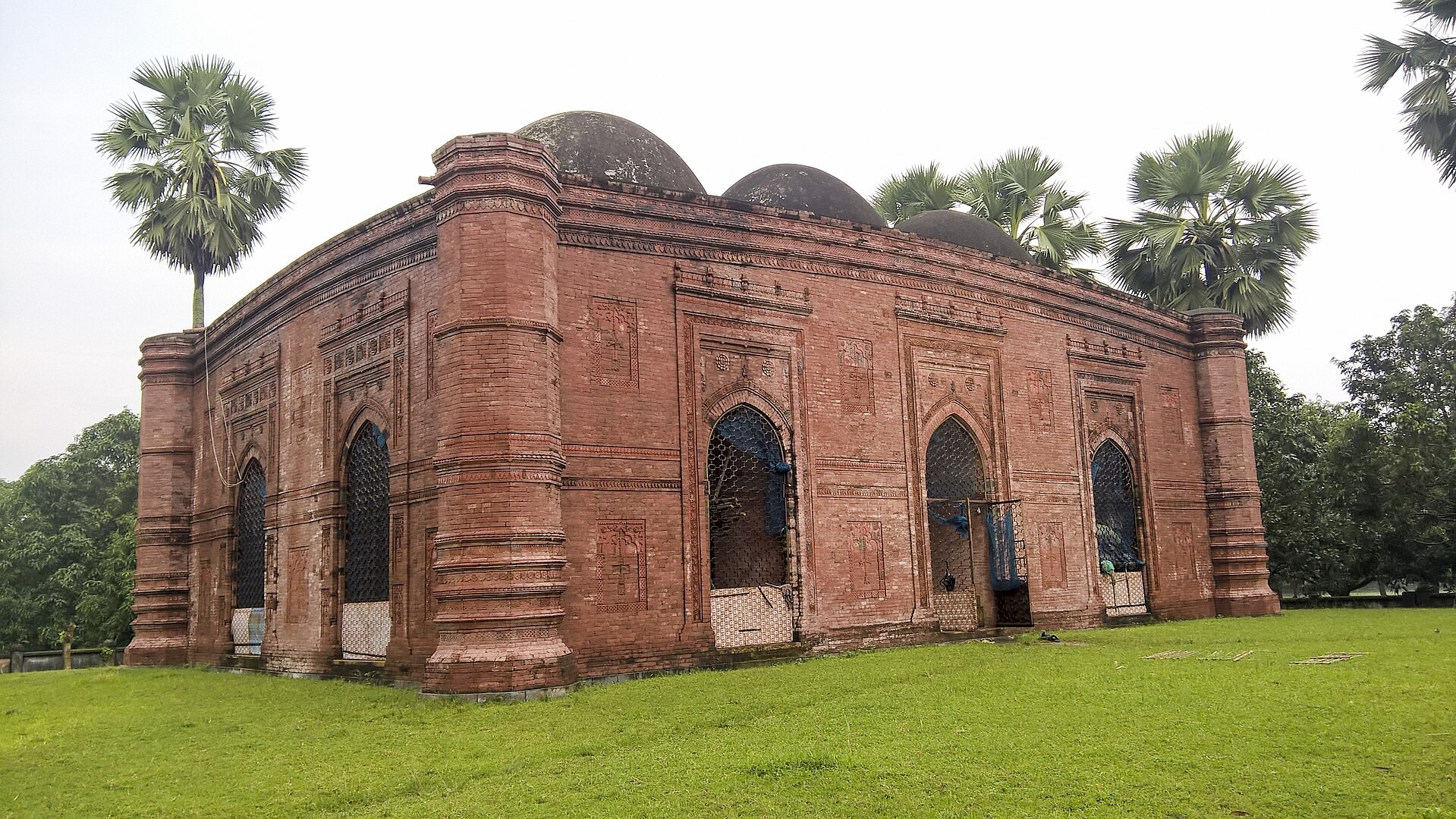
Dhunichak Mosque is a fine example of the later Ilyas Shahi architectural tradition, dating stylistically to the late Sultanate period. Located in Rajshahi, this elegant mosque features a rectangular prayer hall surmounted by a single dome—simple in form but rich in decorative artistry.
The western wall of the sanctuary is adorned with three beautifully crafted mihrabs, with the central one being the most prominent in size and ornamentation. Above the cusped arches of the mihrabs, the spandrels are intricately decorated with terracotta tree motifs, their branches interwoven with bold rosettes—creating a lively and organic design.
Each mihrab is framed within rectangular borders richly embellished with creeper motifs and layered moldings, showcasing the mastery of terracotta craftsmanship typical of Bengal's Sultanate era.
Goaldi Mosque:
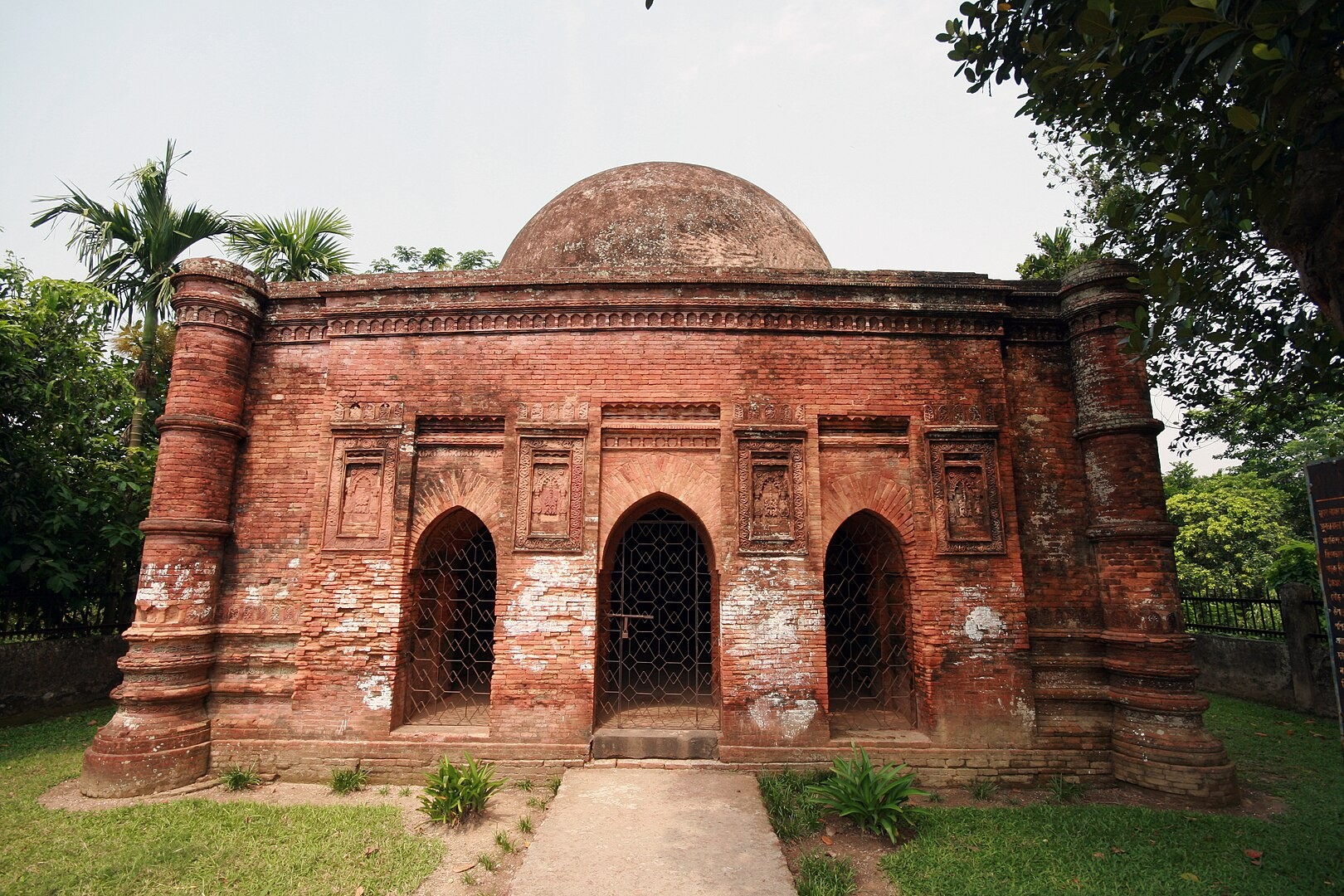
Goaldi Mosque is a beautifully preserved single-domed structure from the Sultanate period, located just half a mile northeast of the historic Panam Nagar in Sonargaon. Built in 1519 by Hizabar Akbar Khan during the reign of Sultan Hussain Shah, this mosque exemplifies the elegance and compactness of late medieval Bengali mosque architecture.
The mosque measures a modest 16 feet square, yet its architectural detailing is remarkably refined. The prayer chamber features three mihrabs on the western wall, each richly adorned with intricate ornamentation. The central mihrab is the most striking—carved in black stone and embellished with floral and arabesque motifs in delicate relief. The side mihrabs, though smaller, are no less beautiful, featuring fine terracotta work and brick detailing that complement the central niche.
Khaniadighi Or Rajbibi Mosque:
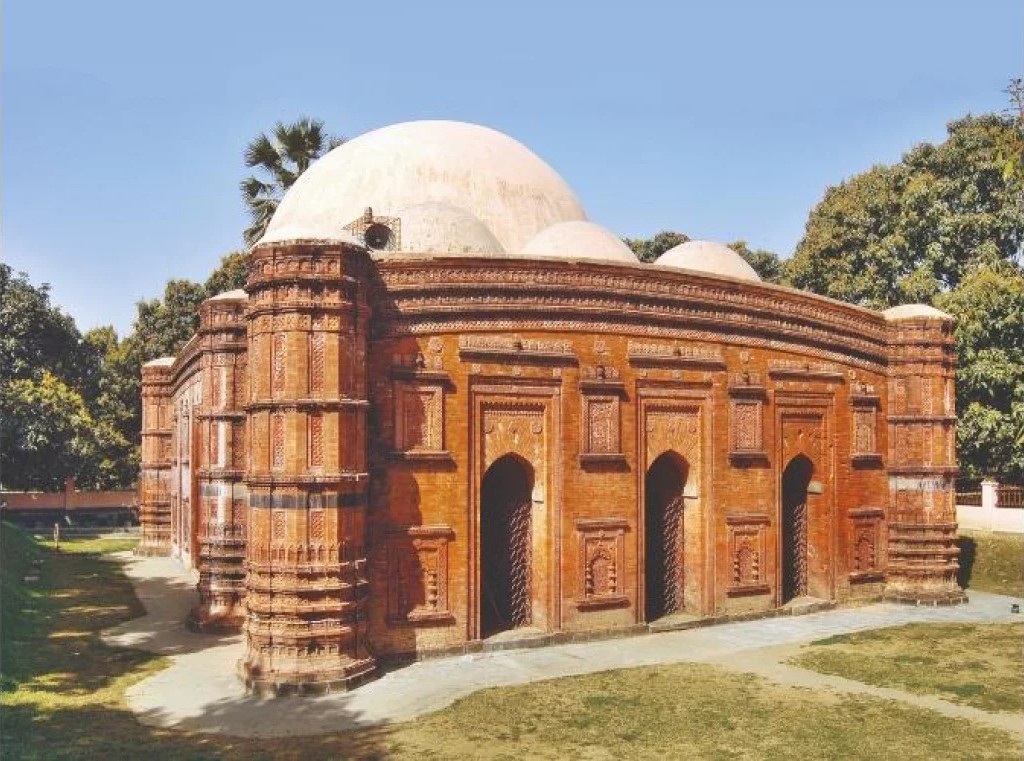
The Khaniadighi Mosque, also known as the Rajbibi Mosque, is a beautifully preserved single-domed square mosque, complemented by an attached verandah roofed with three smaller squat domes. This elegant structure stands out for its intricate detailing and architectural harmony.
The exterior walls are richly adorned with terracotta floral motifs, while sparse but refined stone carvings add a layer of sophistication. Inside the sanctuary, the central dome is supported by a series of robust black basalt pillars. The western wall of the prayer chamber features three exquisitely carved black stone mihrabs, each showcasing the high level of craftsmanship characteristic of the period.
An Arabic inscription bearing Quranic verses still remains on site, suggesting the mosque was built in the 15th century. Though the true identity of Rajbibi remains uncertain, historical speculation suggests she may have been a prominent woman from the royal harem—perhaps a patron or dedicatee of the mosque.
Kusumba Mosque:
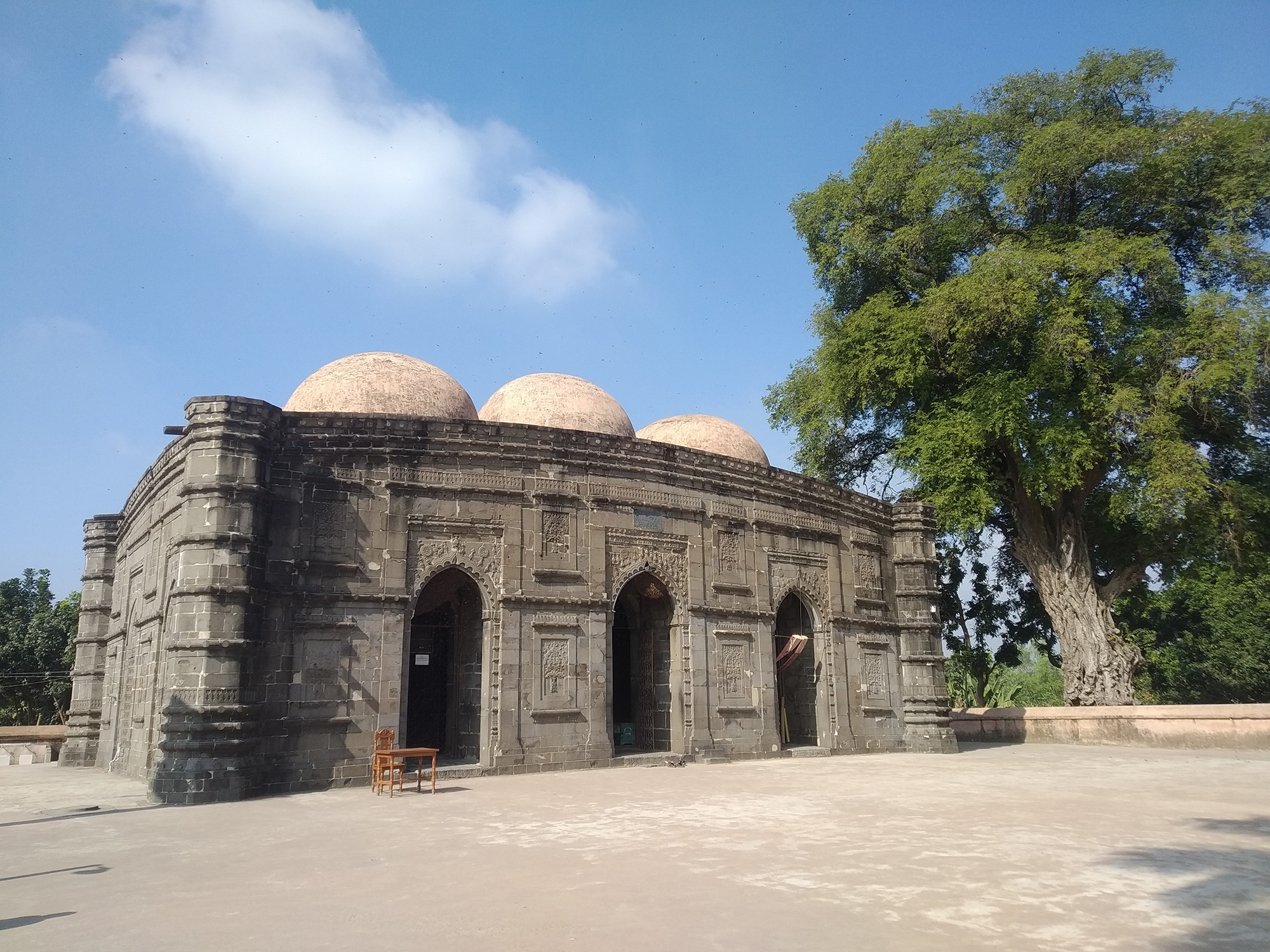
Kusumba Mosque stands as the finest example of the later Sultanate period mosques in Bengal. Constructed in 1558 by a certain Sulaiman during the reign of Sultan Ghiyasuddin Bahadur Shah I, this rectangular mosque is crowned with six impressive hemispherical domes.
Among the early Islamic or Sultanate period stone mosques in greater Bengal, only six have survived—and Kusumba Mosque is one of the rare gems. Its construction features dark black basalt stones, carefully transported from the Rajmahal hills in Bihar via waterways, lending the mosque its distinctive and robust appearance.
A notable architectural feature is the well-designed raised gallery supported by massive stone pillars located at the northwest corner. Accessed by a staircase leading from the prayer room’s ground level, this gallery is unique. Unlike many mosques, there are no handrails along these steps, and more importantly, the internal staircase remains unscreened. This rare design indicates that the gallery was reserved for the Sultan, rulers, builders, or their close entourage—not for women, as commonly misunderstood. Kusumba Mosque’s architectural uniqueness and historical significance earn it the number three spot on our list of the best historical mosques in Bangladesh.
Sura Mosque:
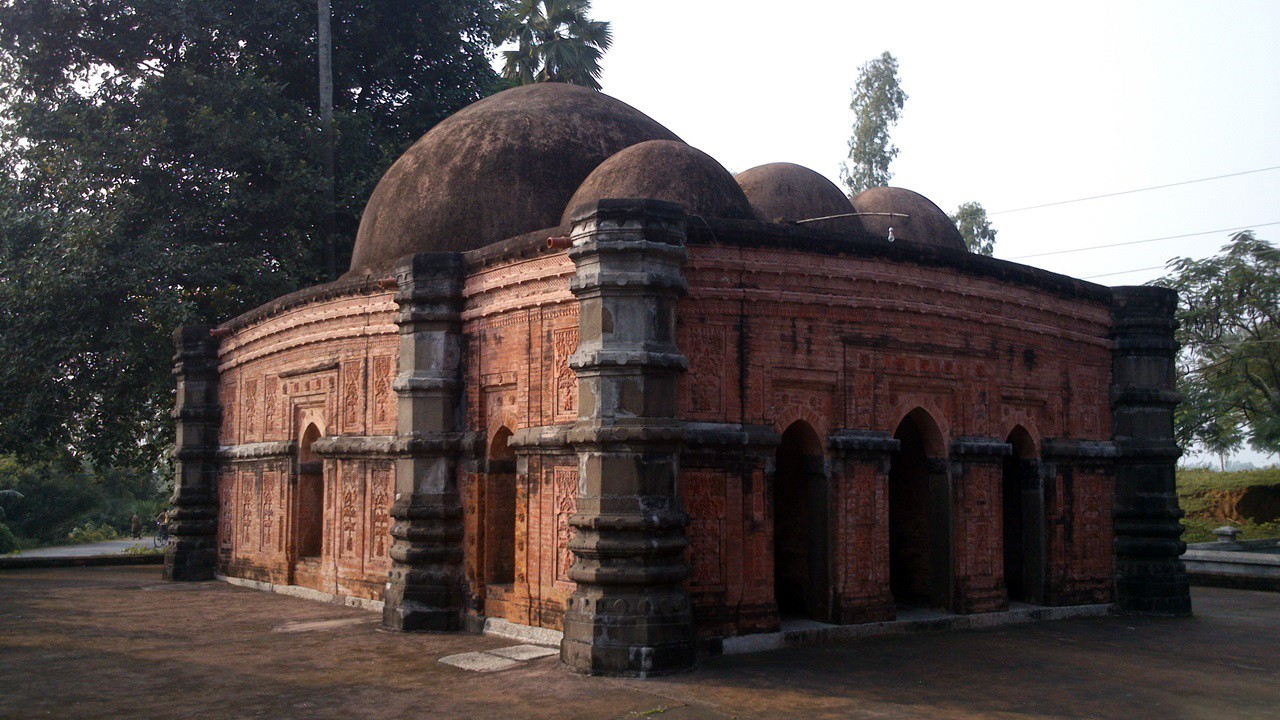
Sura Mosque is a striking example of late Sultanate period architecture, showcasing a refined blend of brick and stone craftsmanship. Located in Rajshahi, this beautifully preserved mosque follows the traditional layout of its era, with a square prayer hall fronted by an eastern corridor.
The structure features six octagonal corner turrets and a gracefully curved cornice that enhances its architectural elegance. The western wall houses three intricately designed mihrabs, richly adorned with bold terracotta ornamentation depicting floral and geometric motifs. The prayer hall is covered by a single tall, bulbous dome resting on squinch arches, while the eastern corridor is spanned by three smaller domes.
Echoing the design style of the Chhoto Sona Masjid in Gaur, Sura Mosque is notable for its finely carved stone facades, which lend a sense of depth and texture to the entire structure.
Chunakhola Mosque:
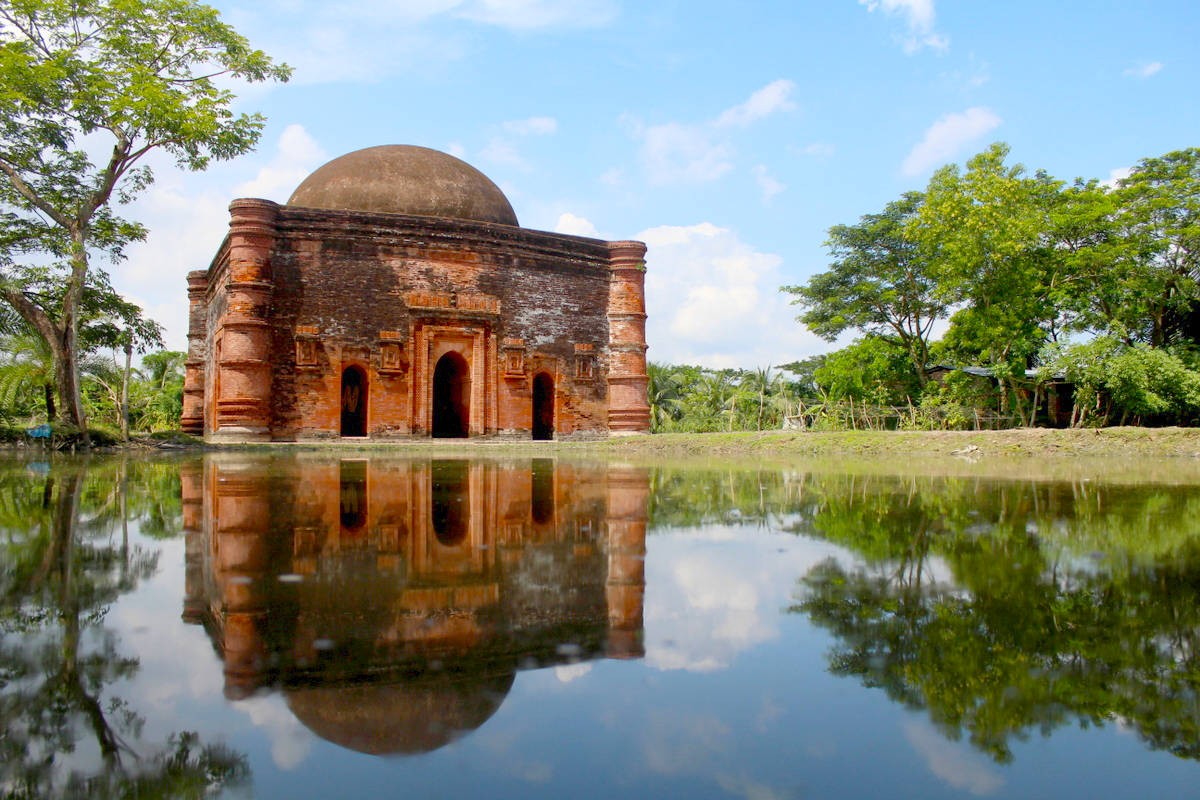
Chunakhola Mosque is a serene and solitary architectural relic, set picturesquely on a low mound amidst the vast, flat stretches of cultivated fields in southwestern Bangladesh. This small, single-domed mosque echoes the design of the nearby Singair Mosque, sharing a similar layout and structural proportions.
Though modest in scale, the mosque carries the quiet dignity of the Sultanate period. Like many of its counterparts in the region, it has endured significant weathering over time, with much of its surface detail lost to the harsh climate. Despite this, the overall form and charm of the structure remain intact—an enduring symbol of the architectural legacy of rural Bengal.
Darasbari Mosque:
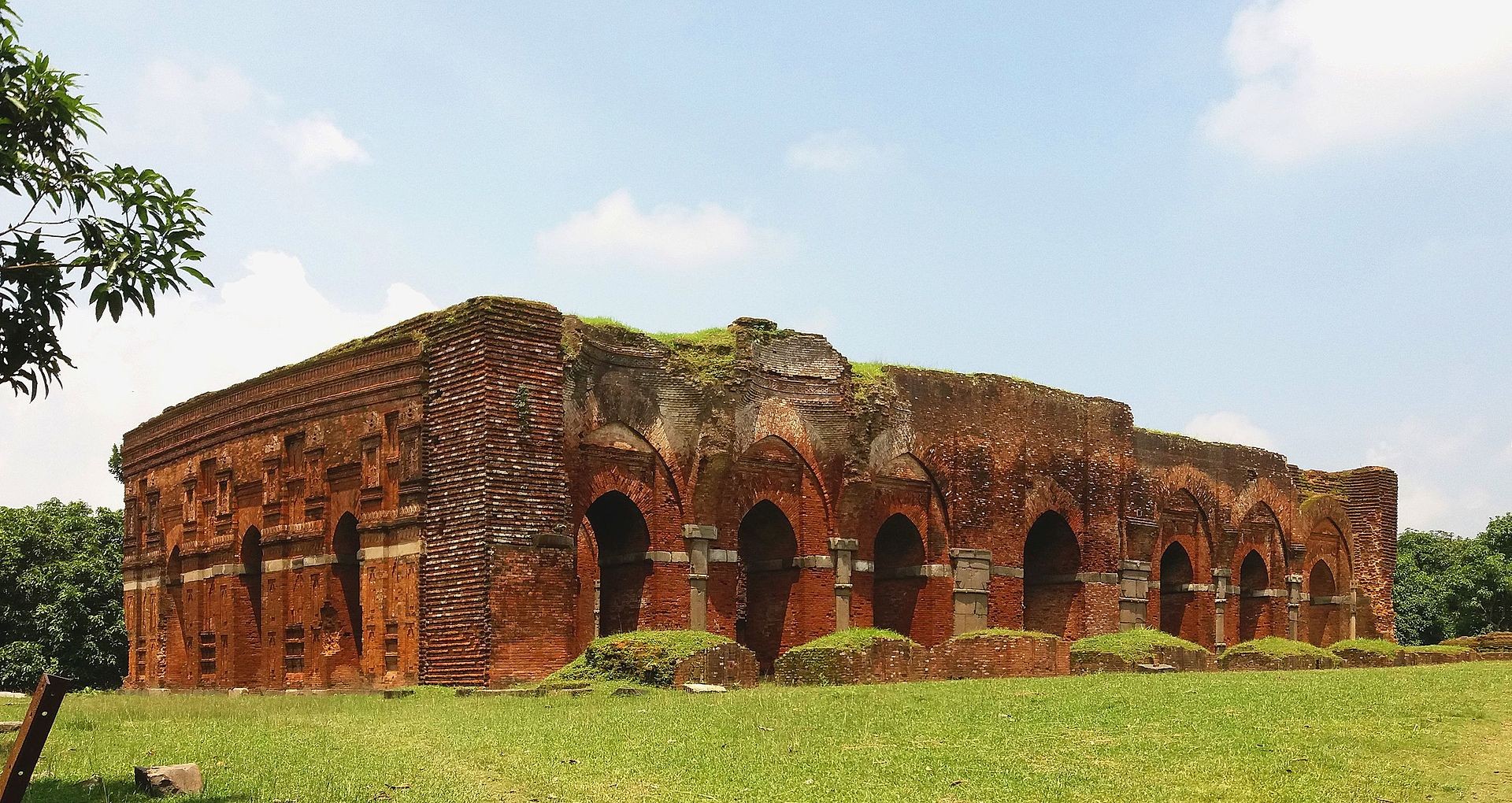
Darasbari Mosque is an elegant example of the matured architectural style of the Ilyas Shahi period. Believed to have been constructed around 1470 by Sultan Yusuf Shah, the mosque reflects the sophistication of Sultanate-era design in Bengal.
The mosque’s prayer hall is entered through a verandah with seven arched entrances. Originally, the structure was roofed with a series of domes, likely including a set of chau-chala (Bengali-style) domes along the central row. Although the domes have long since collapsed, their architectural footprint remains evident.
A notable feature is the probable existence of a raised gallery in the northwest corner, accessible by a staircase from outside—suggesting use by the elite or rulers. The western interior wall of the prayer hall is adorned with nine mihrabs, each richly decorated with bold terracotta ornamentation. These display a mix of intricate floral and geometric motifs in deep relief, showcasing the artistic excellence of the era.
Baitul Mukarram National Mosque:

Baitul Mukarram, the National Mosque of Bangladesh, stands as a striking symbol of modern Islamic architecture in the heart of Dhaka. Completed in 1968, this monumental structure was designed by architect Abdulhusein M. Thariani, blending contemporary design principles with traditional Islamic elements. Its bold geometric form and clean lines set it apart from other mosques in the country.
What makes Baitul Mukarram unique is its Kaaba-inspired cube-shaped structure, which gives it a distinctive identity. The mosque's main prayer hall is vast, capable of accommodating over 30,000 worshippers, making it one of the largest mosques in South Asia. The mosque complex also includes a large courtyard, wide staircases, and extended prayer spaces to accommodate overflow crowds during Eid and Jumu’ah prayers.
The mosque’s design avoids traditional domes and minarets, instead embracing simplicity and scale to express spiritual grandeur. Inside, the prayer hall is adorned with minimal ornamentation, focusing attention on worship and reflection. Baitul Mukarram serves not only as a place of worship but also as a central hub for religious events, sermons, and national congregational prayers.
Chandanpura Mosque:
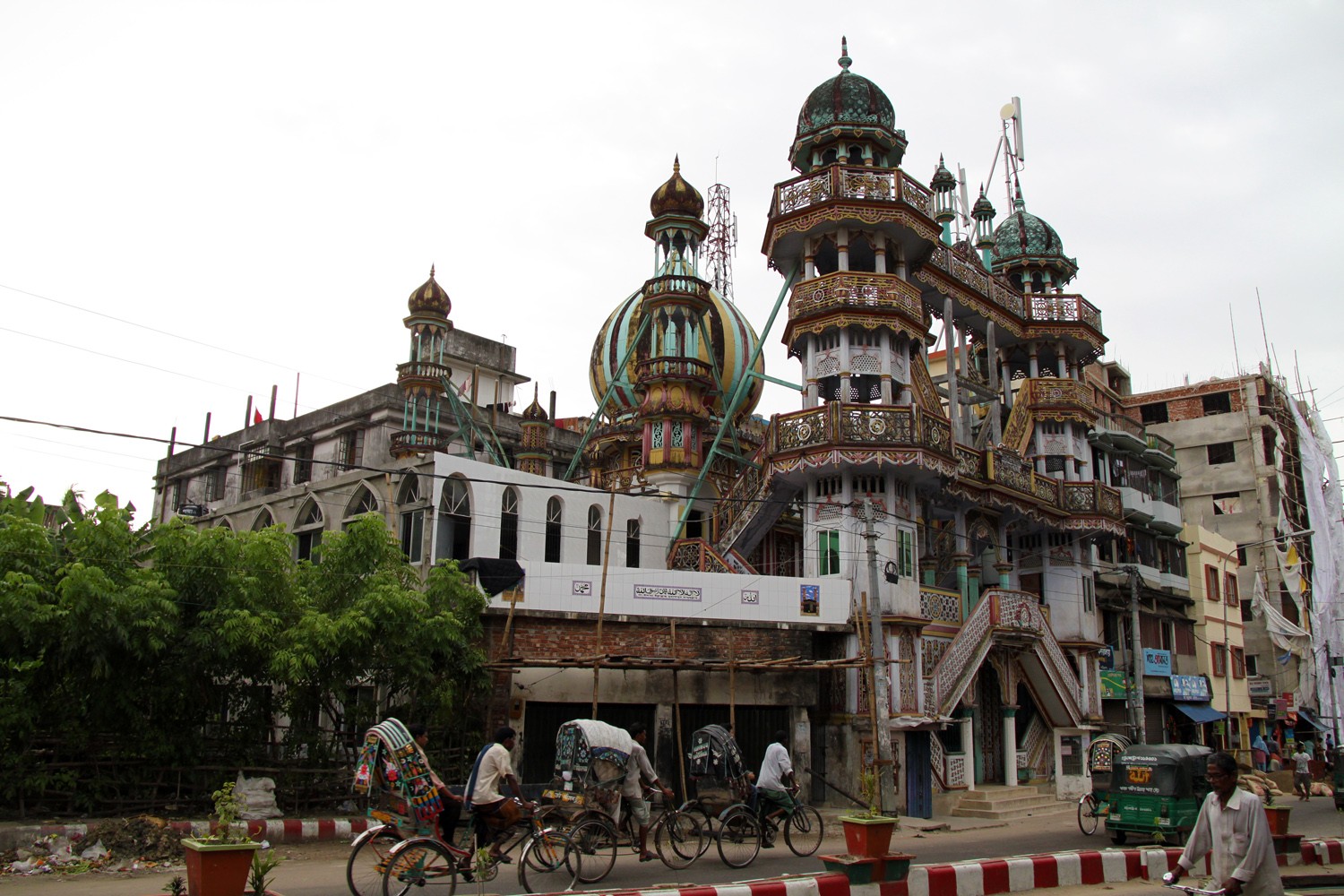
Chandanpura Mosque, located in the heart of Chattogram, is one of the most visually captivating mosques in Bangladesh. Originally built in the late 19th century during the British colonial period, the mosque has since undergone several renovations, yet it retains its historic and architectural charm.
What makes Chandanpura Mosque truly unique is its vibrant façade, crowned with multiple domes and minarets painted in striking shades of green, red, and white. The multicolored onion-shaped domes, embellished with ornate detailing, give the mosque a distinctive skyline that sets it apart from traditional Sultanate or Mughal-era mosques.
The mosque complex is built on an elevated platform, and its symmetrical layout is accentuated by decorative parapets, curvilinear motifs, and delicate latticework on windows and arches. Though not vast in scale, the structure’s aesthetic appeal lies in its fusion of Mughal and Colonial-era design elements, combined with vivid colors that reflect the cultural diversity of Chattogram.
Chawkbazar Shahi Mosque:
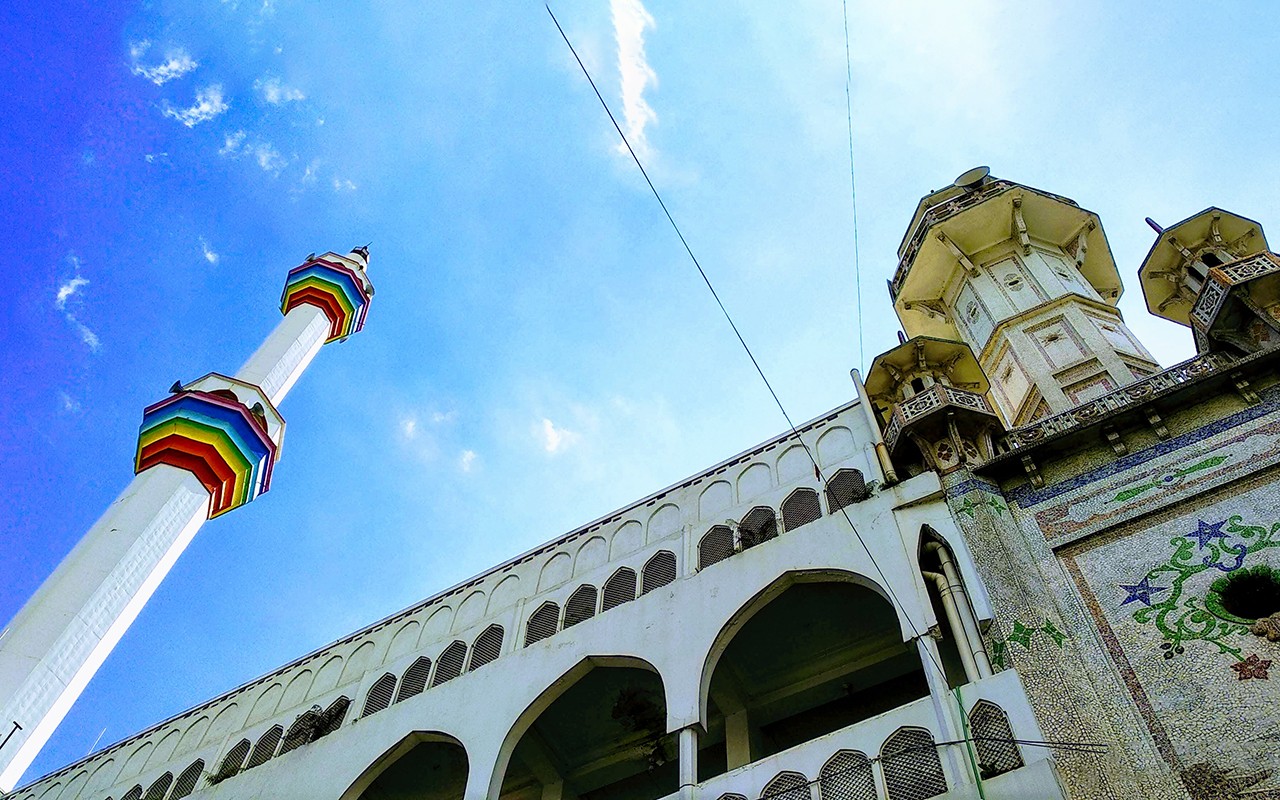
Chawkbazar Shahi Mosque, located in the bustling heart of Old Dhaka, is one of the earliest surviving examples of Mughal-era mosque architecture in Bangladesh. Commissioned by Subahdar Shaista Khan around 1664, this mosque was originally part of a larger madrasa complex, reflecting the traditional Mughal mosque-madrasa layout.
The mosque is built on a raised platform and follows a rectangular plan. It was originally a three-domed structure—typical of early Mughal mosques—with the central dome larger and more elevated than the flanking ones. Over time, the mosque has undergone significant renovation, including the addition of upper floors and expansions, which have altered its original proportions but not its historical significance.
What remains most notable is the mosque’s arched entrances, fluted minarets, and traces of mughal-style plasterwork and floral motifs. Despite the renovations, the lower level of the mosque still retains its historic core, reflecting the classic Mughal design vocabulary—balanced symmetry, structural elegance, and ornamental restraint.
Dhaka University Central Mosque:

The Dhaka University Central Mosque, also known as the Masjidul Jamiya, is a prominent spiritual and architectural landmark situated within the historic campus of Dhaka University. Built in the early 20th century, the mosque serves not only as a center of worship but also as a symbol of intellectual and cultural unity in one of the country’s most prestigious academic institutions.
The mosque features a modernist design with subtle influences from traditional Islamic architecture. Its most notable elements include a large central dome flanked by two smaller ones, supported by a series of arched entrances and interior columns. The mosque’s spacious prayer hall accommodates thousands of worshippers and is designed to facilitate the university's large and diverse community.
With its clean lines, minimal ornamentation, and serene layout, the mosque provides a calm and contemplative space amid the vibrancy of campus life. The surrounding courtyard and gardens add to the mosque’s tranquil atmosphere, making it a focal point for both religious observance and student gatherings.
Star Mosque (Tara Masjid):
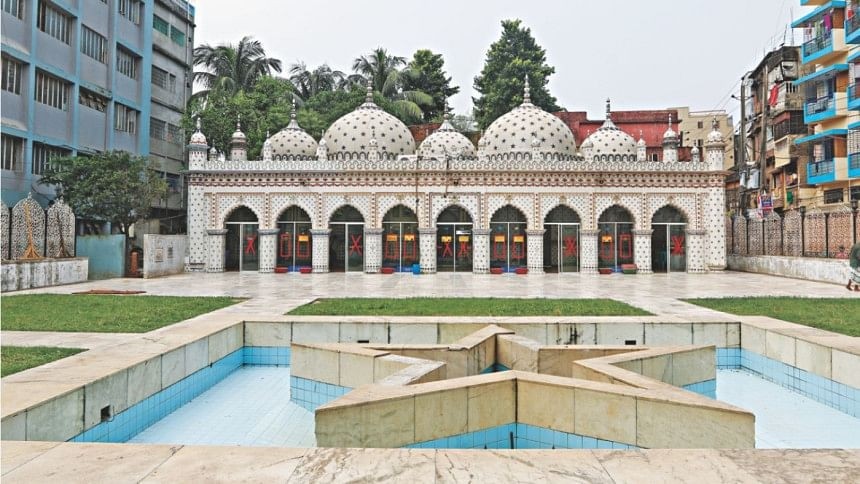
The Star Mosque, locally known as Tara Masjid, is a striking example of ornamental Islamic architecture located in the historic district of Old Dhaka. Built in the early 19th century, it is renowned for its exquisite mosaic work and distinctive star-shaped motifs, which give the mosque its name.
The mosque’s roof and façade are richly decorated with hundreds of blue and white ceramic stars, crafted from broken china and glass. These intricate patterns create a shimmering effect, showcasing the artistic craftsmanship and vibrant cultural heritage of Dhaka’s Muslim community.
Though modest in size, the mosque holds significant historical and spiritual value. Its prayer hall features traditional arched openings, complemented by a serene courtyard used for communal prayers and events. The Star Mosque remains a beloved landmark, celebrated for its unique blend of religious devotion and artistic beauty.
Bangladesh’s historical mosques are more than places of worship—they are enduring monuments of architectural brilliance, cultural legacy, and spiritual depth. From Mughal-inspired domes to intricate terracotta artistry, these sacred sites reflect the country’s rich Islamic heritage and regional craftsmanship. Whether you're a traveler, historian, or architecture lover, exploring these beautiful historical mosques in Bangladesh offers a journey through centuries of devotion and design. As you walk through their ancient corridors and prayer halls, you'll not only witness stunning architecture but also feel the timeless soul of a nation deeply rooted in faith and tradition.




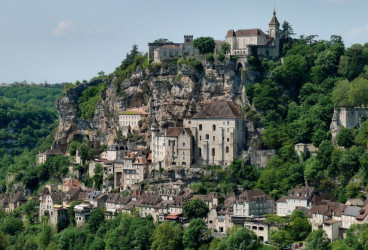







{{item.get_author.first_name}} {{item.get_author.last_name}}
Level 7
5 Photos
36 Reviews
{{item.comment_txt}}
{{item_reply.get_author.first_name}} {{item_reply.get_author.last_name}}
@ {{item_reply.reply_to}}, {{item_reply.reply_txt}}